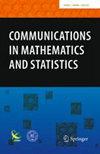偶数字符度和伊藤-米克勒定理
IF 1
4区 数学
Q1 MATHEMATICS
引用次数: 0
摘要
Abstract 让 \(textrm{Irr}_2(G)\) 是有限群 G 的线性偶度不可还原字符集。在本文中,我们证明如果 \(\sum \limits _{\chi \in \textrm{Irr}_2(G)} \chi (1)^m/\sum \limits _{\chi \in \textrm{Irr}_2(G)} \chi (1)^{m-1} <;(1+2^{m-1})/(1+2^{m-2})\) for a positive integer m, which is the generalization of several recent results concerning the well-known Ito-Michler theorem.本文章由计算机程序翻译,如有差异,请以英文原文为准。
Even Character Degrees and Ito–Michler Theorem
Abstract
Let \(\textrm{Irr}_2(G)\) be the set of linear and even-degree irreducible characters of a finite group G. In this paper, we prove that G has a normal Sylow 2-subgroup if \(\sum \limits _{\chi \in \textrm{Irr}_2(G)} \chi (1)^m/\sum \limits _{\chi \in \textrm{Irr}_2(G)} \chi (1)^{m-1} < (1+2^{m-1})/(1+2^{m-2})\) for a positive integer m, which is the generalization of several recent results concerning the well-known Ito–Michler theorem.
求助全文
通过发布文献求助,成功后即可免费获取论文全文。
去求助
来源期刊

Communications in Mathematics and Statistics
Mathematics-Statistics and Probability
CiteScore
1.80
自引率
0.00%
发文量
36
期刊介绍:
Communications in Mathematics and Statistics is an international journal published by Springer-Verlag in collaboration with the School of Mathematical Sciences, University of Science and Technology of China (USTC). The journal will be committed to publish high level original peer reviewed research papers in various areas of mathematical sciences, including pure mathematics, applied mathematics, computational mathematics, and probability and statistics. Typically one volume is published each year, and each volume consists of four issues.
 求助内容:
求助内容: 应助结果提醒方式:
应助结果提醒方式:


